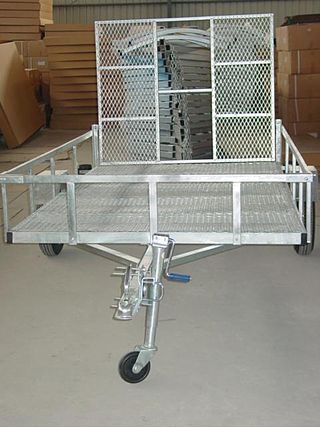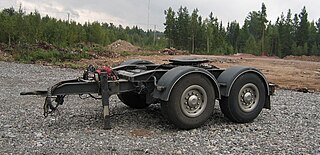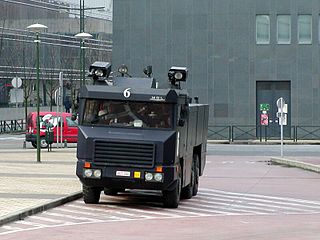
A road train, also known as a land train or long combination vehicle (LCV) is a semi-truck used to move road freight more efficiently than single-trailer semi-trucks. It consists of one semi-trailer or more connected together with or without a tractor. It typically has to be at least three trailers and one tractor.

A trackless train — or tram, road train, land train, or parking lot train is a road-going articulated vehicle used for the transport of passengers, comprising a driving vehicle pulling one or more carriages connected by drawbar couplings, in the manner of a road-going railway train. Similar vehicles may be used for transport of freight or baggage for short distances, such as at a factory or airport. Often depending on use, land train may or may not be skeuomorphically styled to look like traditional, often steam trains.

A trailer is an unpowered vehicle towed by a powered vehicle. It is commonly used for the transport of goods and materials.

A dolly is an unpowered vehicle designed for connection to a tractor unit, truck or prime mover vehicle with strong traction power.

A tractor unit, also known as a truck unit, lorry unit, power unit, prime mover, ten-wheeler, semi-tractor, semi-truck, semi-lorry, tractor cab, truck cab, lorry cab, big rig tractor, big rig truck or big rig lorry or simply a tractor, truck, lorry, semi, big rig or rig, is a characteristically heavy-duty towing engine that provides motive power for hauling a towed or trailered load. These fall into two categories: heavy- and medium-duty military and commercial rear-wheel-drive semi-tractors used for hauling semi-trailers, and very heavy-duty typically off-road-capable, often 6×6, military and commercial tractor units, including ballast tractors.
Mammoet is a privately held Dutch company specializing in engineered heavy lifting and transport of large objects.

A semi-trailer is a trailer without a front axle. The combination of a semi-trailer and a tractor truck is called a semi-trailer truck.
Tadano Faun GmbH is a German manufacturer of mobile cranes based in the Franconian (Bavaria) town of Lauf an der Pegnitz. It is a 100% subsidiary company of the Japanese Tadano Limited. All Tadano all-terrain cranes are developed and produced in the plant in Lauf an der Pegnitz and then distributed across the globe by Tadano Faun GmbH’s global sales and service network.

Ringfeder name is a German brand based in Krefeld founded in 1922. The brand manufactures bolt couplings, hook couplings, drawbar eyes, underrun protections and accessories. Ringfeder is part of VBG Truck Equipment, one of the divisions in the VBG Group, a large international industrial group.

A heavy hauler is a very large transporter for moving oversize loads too large for road travel without an escort and special permit.

A self-propelled modular transporter or sometimes self-propelled modular trailer (SPMT) is a platform heavy hauler with a large array of wheels which is an upgraded version of a hydraulic modular trailer. SPMTs are used for transporting massive objects, such as large bridge sections, oil refining equipment, cranes, motors, spacecraft and other objects that are too big or heavy for trucks. Ballast tractors can however provide traction and braking for the SPMTs on inclines and descents.

A ballast tractor is a specially weighted tractor unit of a heavy hauler combination. It is designed to utilize a drawbar to pull or push heavy or exceptionally large trailer loads which are loaded in a hydraulic modular trailer. When feasible, lowboy-style semi-trailers are used to minimize the height of a load's center of mass. Typical drivetrains are 6×4 and 6×6, but 8×6 and 8×8 are also available. Typical ballast tractor loads include oil rig modules, bridge sections, buildings, ship sections, and industrial machinery such as generators and turbines.

A drawbar is a solid coupling between a hauling vehicle and its hauled load. Drawbars are in common use with rail transport, road trailers, both large and small, industrial and recreational, and with agricultural equipment.

A tank transporter is a combination of a heavy tractor unit or a ballast tractor and a mating full trailer, hydraulic modular trailer or semi-trailer, used for transporting tanks and other armoured fighting vehicles. Some also function as tank recovery vehicles, the tractors of which may be armoured for protection in combat conditions.

A lowboy is a semi-trailer with two drops in deck height: one right after the gooseneck and one right before the wheels. This allows the deck to be extremely low compared with other trailers. It offers the ability to carry legal loads up to 12 ft (3.66 m) tall, which other trailers cannot. Lowboys are used to haul heavy equipment such as bulldozers and large industrial equipment.

Willème was a French truck manufacturer.

MOL is a manufacturer of specialist trucks and trailers, based in Hooglede, Belgium. Specializes in manufacturing of trailers, waste vehicles, port equipement, trucks and rail equipments.

Nicolas Industrie S.A.S. is a French manufacturer of heavy trucks, trailers, HMT and SPMTs, mostly intended for oversize loads. Nicolas has been located in Champs-sur-Yonne since 1969, which is also when they started to develop vehicles meant particularly for very heavy loads. Their trucks, sold under the Tractomas brand, are built to single order. They most often incorporate Renault cabs and other parts, as well as a number of proprietary parts from manufacturers around the world. The Nicolas Tractomas TR1010 D100 currently holds the record as the world's largest road going truck, weighing in at 71 tonnes.

Faymonville Group is a trailer and heavy transport equipment manufacturer operating worldwide. Started back in the 1960s in Rocherath, Belgium as a blacksmith shop later started to manufacture and sell agriculture machines and tractor cabins in 1962 opened a new production unit to fulfill the demand of forestry vehicles. In the late 1960s, the company manufactured its first semi-trailer. Today it manufactures every type of trailer for different transportation needs, ranging from flatbeds to SPMTs. With 4 production facilities spread around Europe in Luxembourg, Belgium, Poland and Italy while having its headquarters in Luxembourg.

Nicolas Tractomas is a heavy-duty built-to-order ballast tractor specifically to tow hydraulic modular trailers and road trains used for movement of oversize loads manufactured by French manufacturer Nicolas Industrie based in Auxerre. The tractor was bespoke build with preferred engine, gearbox, drivetrain and ballast with a Renault kerax cabin. The production of the tractor began in 1979 and lasted till 2016. The TR1010 D100 model of the tractor was awarded the Guinness World Record in 2015 for the largest road truck in the world, weighing 71 tons.






























